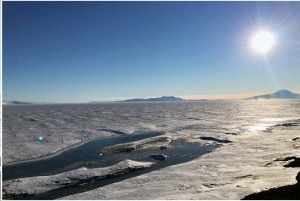First detailed atmospheric measurements reveal influences of warm air
From an Article by David Bromwich, et.al., Los Alamos National Laboratory, June 20, 2017
Scientists report that meltwater last summer formed on a large part of the surface of a major Antarctic ice sheet, extending over an area that was more than twice the size of California. This extensive surface melting was likely linked to a strong El Niño event, according to the team, and it is one of the most prominent surface melt events ever recorded in West Antarctica.
The team collected the first substantial field observations on the West Antarctic Ice Sheet in 50 years and reported findings in the June 15 in Nature Communications. The study was the first to collect detailed measurements of atmospheric conditions and physical processes that help elucidate melt causes, including warm ocean air that extended as far as the Antarctica ice sheets.
“Antarctica is an extremely challenging environment to collect data, and that is why there are so few historical measurements from there, not only from the remote interior of the continent but also from its coastal ice sheets,” said Los Alamos National Laboratory’s Heath Powers, study coauthor and instrument and engineering team lead for this research. “Our capabilities of bringing state-of-the-art measurements to these very difficult but critical study areas is crucial to understanding how ice sheets respond to changes in the atmosphere, ocean, and climate. It is very rewarding to see these important findings resulting from our measurements.”
The historic 14-month field campaign, called the ARM West Antarctic Radiation Experiment (AWARE), began in late 2015 and was a partnership between the U.S. Department of Energy’s Atmospheric Radiation Measurement (ARM) Research Facility and the National Science Foundation (NSF). A team from Los Alamos National Laboratory’s Earth and Environmental Sciences Division deployed and managed ARM’s mobile research facilities at McMurdo Station and the West Antarctic Ice Sheet.
This melt could have global implications. Antarctica contains among the world’s largest ice sheets, and the West Antarctica Ice Sheet contains enough mass to raise sea levels by 11 feet or more if it ever becomes destabilized and fully melts.
Los Alamos participates in research to discover and understand signatures of change within complex climate and earth systems as part of its mission to understand their impacts and threats to global security.
Study finds warm maritime air penetrating barriers
ARM’s unique, advanced cloud and aerosol instruments probed the frigid atmosphere and provided a sophisticated, complete observational data set to elucidate key processes that influence the dynamical coupling between the ice sheet and lower atmosphere. The data are freely available to researchers worldwide.
Clouds reflect or absorb heat depending on their composition. The AWARE data revealed that Antarctic clouds during the campaign had a stronger heat-trapping effect than previously assumed. Recent satellite observations of rapid loss of land ice from West Antarctica has been attributed to warm ocean water destabilizing ice shelves from below. This study demonstrates that melting at the surface of the ice sheet by a warm and moist atmosphere could become very important in the near future.
Strong westerly winds to the north of West Antarctica have previously been assumed to prevent anomalous atmospheric warming episodes (such as from El Nino) from influencing the Antarctic ice sheets. AWARE data challenges this idea. Based on ARM observations, researchers now see at the same time a strong remote influence of El Niño in driving warm air and moisture over West Antarctica. The data collected also supports the team’s hypothesis that in a changing climate warm air associated with, e.g., El Nino episodes, could become increasingly important as a mechanism able to drive Antarctic ice loss.
The AWARE science team is a collaboration of researchers from Scripps Institution of Oceanography, which led the study; Pennsylvania State University; Ohio State University and Brookhaven National Laboratory.
The team’s new findings, based on AWARE’s unprecedented data set, are already helping researchers demystify Antarctica’s role in the global climate.
“In West Antarctica, we have a tug-of-war going on between the influence of El Niños and the westerly winds, and it looks like the El Niños are winning,” said study co-author David Bromwich, Ohio State University professor. “And because model simulations suggest that El Niños may amplify in the future with a warming climate, we should expect more surface melt events as we observed last year may occur in West Antarctica over the upcoming years.”
Funding: The Los Alamos work was funded by the US Department of Energy’s Office of Science.
Additional Reading:
Washington Post — Scientists stunned by Antarctic rainfall and a melt area bigger than Texas
ARM web feature: With ARM Instruments Watching, an Extensive Summer Melt in West Antarctica
News Release, The Ohio State University: Widespread snowmelt in West Antarctica during unusually warm summer

